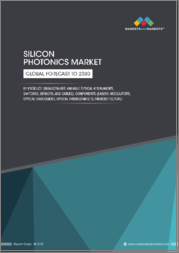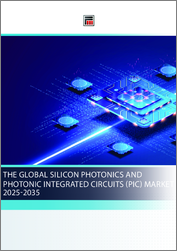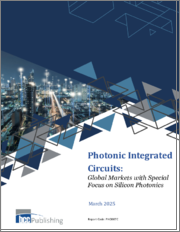
|
시장보고서
상품코드
1609700
일본의 실리콘 포토닉스 시장 보고서 : 제품, 부품, 응용 분야, 지역별(2025-2033년)Japan Silicon Photonics Market Report by Product, Component (Optical Waveguides, Optical Modulators, Photodetectors, Wavelength-Division Multiplexing Filters, Laser), Application, and Region 2025-2033 |
||||||
일본의 실리콘 포토닉스 시장 규모는 2024년 1억 390만 달러로 추정됩니다. 향후 IMARC Group은 2033년까지 8억 1,960만 달러에 달할 것으로 예상하며, 2025년부터 2033년까지 25.8%의 연평균 성장률(CAGR)을 나타낼 것으로 전망하고 있습니다.에 대한 수요 증가와 실리콘 포토닉스와 같은 광통신 기술의 새로운 보급이 시장을 주도하고 있습니다.
본 보고서에서 다룬 주요 질문
- 일본의 실리콘 포토닉스 시장은 지금까지 어떻게 성장해왔고, 앞으로 어떻게 발전할 것인가?
- 코로나19가 일본 실리콘 포토닉스 시장에 미치는 영향은?
- 일본 실리콘 포토닉스 시장 제품별 현황은?
- 일본 실리콘 포토닉스 시장의 구성요소별 시장 현황은?
- 일본의 실리콘 포토닉스 시장 용도별 시장 현황은?
- 일본 실리콘 포토닉스 시장의 밸류체인에는 어떤 단계가 있는가?
- 일본 실리콘 포토닉스의 주요 촉진요인과 과제는?
- 일본 실리콘 포토닉스 시장 구조와 주요 업체는?
- 일본 실리콘 포토닉스 시장에서의 경쟁은 어느 정도인가?
목차
제1장 서문
제2장 조사 범위와 조사 방법
- 조사 목적
- 이해관계자
- 데이터 소스
- 시장 추정
- 조사 방법
제3장 주요 요약
제4장 일본의 실리콘 포토닉스 시장 : 서론
- 개요
- 시장 역학
- 업계 동향
- 경쟁 정보
제5장 일본의 실리콘 포토닉스 시장 구도
- 과거 및 현재 시장 동향(2019-2024년)
- 시장 예측(2025-2033년)
제6장 일본의 실리콘 포토닉스 시장 : 제품별 분석
- 트랜시버
- 액티브 광케이블
- 광멀티플렉서
- 광감쇠기
- 기타
제7장 일본의 실리콘 포토닉스 시장 : 컴포넌트별 분석
- 광도파로
- 광변조기
- 광검출기
- 파장분할다중(WDM) 필터
- 레이저
제8장 일본의 실리콘 포토닉스 시장 : 용도별 분석
- IT 및 통신
- 가전
- 헬스케어 및 생명과학
- 상업
- 방위 및 안보
- 기타
제9장 일본의 실리콘 포토닉스 시장 : 경쟁 구도
- 개요
- 시장 구조
- 시장 기업 포지셔닝
- 주요 성공 전략
- 경쟁 대시보드
- 기업 평가 상한
제10장 주요 기업 개요
제11장 일본의 실리콘 포토닉스 시장 : 업계 분석
- 성장 촉진요인 및 억제요인과 기회
- Porter의 Five Forces 분석
- 밸류체인 분석
제12장 부록
LSH 24.12.23Japan silicon photonics market size reached USD 103.9 Million in 2024. Looking forward, IMARC Group expects the market to reach USD 819.6 Million by 2033, exhibiting a growth rate (CAGR) of 25.8% during 2025-2033. The increasing demand for need for high-speed data transmission in various applications such as 5G networks, AI, and IoT, coupled with the emerging popularity of optical communication technologies like silicon photonics, is driving the market.
Silicon photonics is an emerging technology that integrates optical components and circuits on silicon-based chips to transmit data using light instead of electricity. It harnesses the properties of silicon, the dominant material in the electronics industry, to enable high-speed data transfer and processing with minimal energy consumption. In silicon photonics, lasers or modulators create and manipulate light signals on silicon substrates, which can be easily integrated into existing semiconductor manufacturing processes. This technology is crucial for data centers, telecommunications, and high-performance computing, where the demand for faster and more energy-efficient data transfer is increasing. Silicon photonics offers advantages such as high bandwidth, low latency, and immunity to electromagnetic interference, making it ideal for transmitting vast amounts of data over long distances. It also facilitates the convergence of optical and electronic functions on a single chip, reducing cost and complexity. Overall, silicon photonics holds immense promise for revolutionizing communication and computing by enabling faster, more efficient, and cost-effective data transmission using light-based technologies.
Japan Silicon Photonics Market Trends:
The silicon photonics market in Japan is experiencing a remarkable surge, primarily driven by the incessant demand for high-speed data transmission and the growing need for energy-efficient solutions. Additionally, the proliferation of cloud computing and data centers has significantly bolstered the market, as silicon photonics provides an optimal solution for managing vast data loads with enhanced performance and reduced latency. Furthermore, the integration of silicon photonics in consumer electronics, particularly for applications like high-resolution displays and advanced sensing, is propelling market growth. Moreover, the telecommunication sector is leveraging silicon photonics for faster and more reliable network connections, thereby contributing to market expansion. Equally important, the automotive industry's adoption of silicon photonics for LiDAR and other sensing technologies is creating new growth avenues. Also, the escalating demand for high-performance computing is propelling market players to invest in silicon photonics, ensuring a competitive edge. Correspondingly, advancements in technology and innovation are making silicon photonics more accessible and cost-effective, thus driving market adoption. Consequently, with the integration of artificial intelligence and machine learning, silicon photonics is becoming indispensable for various industries, ensuring sustained market growth. All in all, the synergy of market drivers, such as technological advancements, growing demand from key industries, and the need for energy-efficient solutions, is ensuring a robust trajectory for the silicon photonics market in Japan.
Japan Silicon Photonics Market Segmentation:
Product Insights:
- Transceivers
- Active Optical Cables
- Optical Multiplexers
- Optical Attenuators
- Others
Component Insights:
- Optical Waveguides
- Optical Modulators
- Photodetectors
- Wavelength-Division Multiplexing (WDM) Filters
- Laser
Application Insights:
- IT and Telecommunications
- Consumer Electronics
- Healthcare and Life Sciences
- Commercial
- Defense and Security
- Others
Competitive Landscape:
The market research report has also provided a comprehensive analysis of the competitive landscape in the market. Competitive analysis such as market structure, key player positioning, top winning strategies, competitive dashboard, and company evaluation quadrant has been covered in the report. Also, detailed profiles of all major companies have been provided.
Key Questions Answered in This Report:
- How has the Japan silicon photonics market performed so far and how will it perform in the coming years?
- What has been the impact of COVID-19 on the Japan silicon photonics market?
- What is the breakup of the Japan silicon photonics market on the basis of product?
- What is the breakup of the Japan silicon photonics market on the basis of component?
- What is the breakup of the Japan silicon photonics market on the basis of application?
- What are the various stages in the value chain of the Japan silicon photonics market?
- What are the key driving factors and challenges in the Japan silicon photonics?
- What is the structure of the Japan silicon photonics market and who are the key players?
- What is the degree of competition in the Japan silicon photonics market?
Table of Contents
1 Preface
2 Scope and Methodology
- 2.1 Objectives of the Study
- 2.2 Stakeholders
- 2.3 Data Sources
- 2.3.1 Primary Sources
- 2.3.2 Secondary Sources
- 2.4 Market Estimation
- 2.4.1 Bottom-Up Approach
- 2.4.2 Top-Down Approach
- 2.5 Forecasting Methodology
3 Executive Summary
4 Japan Silicon Photonics Market - Introduction
- 4.1 Overview
- 4.2 Market Dynamics
- 4.3 Industry Trends
- 4.4 Competitive Intelligence
5 Japan Silicon Photonics Market Landscape
- 5.1 Historical and Current Market Trends (2019-2024)
- 5.2 Market Forecast (2025-2033)
6 Japan Silicon Photonics Market - Breakup by Product
- 6.1 Transceivers
- 6.1.1 Overview
- 6.1.2 Historical and Current Market Trends (2019-2024)
- 6.1.3 Market Forecast (2025-2033)
- 6.2 Active Optical Cables
- 6.2.1 Overview
- 6.2.2 Historical and Current Market Trends (2019-2024)
- 6.2.3 Market Forecast (2025-2033)
- 6.3 Optical Multiplexers
- 6.3.1 Overview
- 6.3.2 Historical and Current Market Trends (2019-2024)
- 6.3.3 Market Forecast (2025-2033)
- 6.4 Optical Attenuators
- 6.4.1 Overview
- 6.4.2 Historical and Current Market Trends (2019-2024)
- 6.4.3 Market Forecast (2025-2033)
- 6.5 Others
- 6.5.1 Historical and Current Market Trends (2019-2024)
- 6.5.2 Market Forecast (2025-2033)
7 Japan Silicon Photonics Market - Breakup by Component
- 7.1 Optical Waveguides
- 7.1.1 Overview
- 7.1.2 Historical and Current Market Trends (2019-2024)
- 7.1.3 Market Forecast (2025-2033)
- 7.2 Optical Modulators
- 7.2.1 Overview
- 7.2.2 Historical and Current Market Trends (2019-2024)
- 7.2.3 Market Forecast (2025-2033)
- 7.3 Photodetectors
- 7.3.1 Overview
- 7.3.2 Historical and Current Market Trends (2019-2024)
- 7.3.3 Market Forecast (2025-2033)
- 7.4 Wavelength-Division Multiplexing (WDM) Filters
- 7.4.1 Overview
- 7.4.2 Historical and Current Market Trends (2019-2024)
- 7.4.3 Market Forecast (2025-2033)
- 7.5 Laser
- 7.5.1 Overview
- 7.5.2 Historical and Current Market Trends (2019-2024)
- 7.5.3 Market Forecast (2025-2033)
8 Japan Silicon Photonics Market - Breakup by Application
- 8.1 IT and Telecommunications
- 8.1.1 Overview
- 8.1.2 Historical and Current Market Trends (2019-2024)
- 8.1.3 Market Forecast (2025-2033)
- 8.2 Consumer Electronics
- 8.2.1 Overview
- 8.2.2 Historical and Current Market Trends (2019-2024)
- 8.2.3 Market Forecast (2025-2033)
- 8.3 Healthcare and Life Sciences
- 8.3.1 Overview
- 8.3.2 Historical and Current Market Trends (2019-2024)
- 8.3.3 Market Forecast (2025-2033)
- 8.4 Commercial
- 8.4.1 Overview
- 8.4.2 Historical and Current Market Trends (2019-2024)
- 8.4.3 Market Forecast (2025-2033)
- 8.5 Defense and Security
- 8.5.1 Overview
- 8.5.2 Historical and Current Market Trends (2019-2024)
- 8.5.3 Market Forecast (2025-2033)
- 8.6 Others
- 8.6.1 Historical and Current Market Trends (2019-2024)
- 8.6.2 Market Forecast (2025-2033)
9 Japan Silicon Photonics Market - Competitive Landscape
- 9.1 Overview
- 9.2 Market Structure
- 9.3 Market Player Positioning
- 9.4 Top Winning Strategies
- 9.5 Competitive Dashboard
- 9.6 Company Evaluation Quadrant
10 Profiles of Key Players
- 10.1 Company A
- 10.1.1 Business Overview
- 10.1.2 Product Portfolio
- 10.1.3 Business Strategies
- 10.1.4 SWOT Analysis
- 10.1.5 Major News and Events
- 10.2 Company B
- 10.2.1 Business Overview
- 10.2.2 Product Portfolio
- 10.2.3 Business Strategies
- 10.2.4 SWOT Analysis
- 10.2.5 Major News and Events
- 10.3 Company C
- 10.3.1 Business Overview
- 10.3.2 Product Portfolio
- 10.3.3 Business Strategies
- 10.3.4 SWOT Analysis
- 10.3.5 Major News and Events
- 10.4 Company D
- 10.4.1 Business Overview
- 10.4.2 Product Portfolio
- 10.4.3 Business Strategies
- 10.4.4 SWOT Analysis
- 10.4.5 Major News and Events
- 10.5 Company E
- 10.5.1 Business Overview
- 10.5.2 Product Portfolio
- 10.5.3 Business Strategies
- 10.5.4 SWOT Analysis
- 10.5.5 Major News and Events
11 Japan Silicon Photonics Market - Industry Analysis
- 11.1 Drivers, Restraints, and Opportunities
- 11.1.1 Overview
- 11.1.2 Drivers
- 11.1.3 Restraints
- 11.1.4 Opportunities
- 11.2 Porters Five Forces Analysis
- 11.2.1 Overview
- 11.2.2 Bargaining Power of Buyers
- 11.2.3 Bargaining Power of Suppliers
- 11.2.4 Degree of Competition
- 11.2.5 Threat of New Entrants
- 11.2.6 Threat of Substitutes
- 11.3 Value Chain Analysis



















